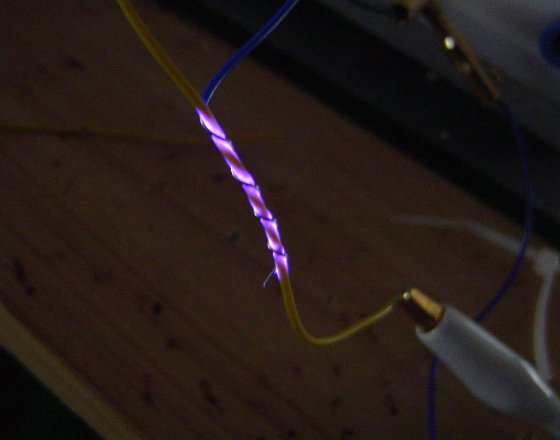While bench testing is often used as the formal evidence of compliance, it is best when paired with design calculations that show a specification can be reliably met with suitable margins, independent of the bench test. The calculator below is intended for use with IEC 60601-2-2 Clauses 201.8.8.3.102 (HF leakage current) and 201.8.8.3.103 (HF dielectric strength). The calculator uses two insulation material properties (relative permittivity, dissipation factor) and three design specifications (insulation thickness, wire or shaft diameter, rated peak voltage) as well as the sample length to estimate capacitance,
HF leakage, HF dielectric strength test parameters, currents and loads, sample heating and temperature rise.
| Parameter | Value | Units | Description/Notes |
| Insulation thickness: (symbol d) |
mm | Insulation thickness on the wiring or shaft (for example, the recovered wall thickness for heatshrink). Typical values are between 0.1 and 0.5mm. HF leakage is inversely proportional to thickness, and dielectric heating is inversely proportional to thickness squared |
|
| Relative permittivity: (symbol ε) |
(unitless) | "Permittivity" relative a vacuum, typical values for insulation are 2.0 to 3.0. Materials with high values such as PVDF (over 8.0) are not recommended as these will have high leakage currents and dielectric heating. | |
| Dissipation Factor (DF): (symbol δ) |
(unitless) | This is the proportion of the apparent power (VA) that gets turned into heat, in effect the resistive part of the insulation. This parameter has a major effect on dielectric heating. In specification sheets this may be expressed as a percentage (e.g. 2% == 0.02) or as "x10-4" (e.g. 200 == 0.02). It is generally recommended to use materials with DF ≤ 0.001 especially for insulation thickness ≤0.3mm. | |
| Shaft or wire diameter: (symbol D) |
mm | This is the diameter of the metal part, excluding the insulation thickness. For wiring this would normally be around 0.3-1.0mm, for shafts typically 3-8mm | |
| Length to analyse: (symbol L) |
cm | This is length in cm to be analysed for total capacitance and loading effects only. Other effects are density based and so the length it not relevant. This is important to consider the loading on the test equipment and ESU | |
| Rated voltage: (symbol Vr) |
Vpeak | This is the rated peak voltage which will be disclosed in the instructions for use. It is used to calculate the test voltage (120%) and test Vrms, expected currents and heating. Note that it should not be confused with Vpp (peak to peak) which is sometimes used for generators. |
| Capacitance density: Symbol Ca |
pF/cm² | Capacitance per unit area, usually in the order of 5-15pF/cm². For compliance with IEC 60601-2-2 this is the most important factor, as effects are density related. High values of capacitance leads to high loading, HF leakage currents and dielectric heating (lower is better) Using C=0.8854ε/d, based on C = ε0εrA/d (F) |
|
| Capacitance of sample: Symbol Cs |
pF | Sample capacitance (or capacitance of length L), which is important for loading of test equipment and also the HF generator (ESU).
Using C = 0.278 εr L (D+d) /d, based on C = ε0εrA/d (F) Notes: *The MEDTEQ HFIT 8.0 is designed for 150pF up to 6kVp and 100pF for 7.2kVp. If necesary shorten to a representative sample length *Excessive sample capacitance can also overload HF generators (ESUs) *This formula uses an approximation of the cylinder capacitor unwrapped into a parallel plate capacitor. A more precise method is C = 2πL/ln(r2/r1) |
|
| HF Leakage (per unit area) (@400Vp 400kHz) |
mA/cm² (Limit 10mA/cm²) |
This estimates the HF leakage current per cm², using Ca, for a sine wave test voltage of 283Vrms (400Vp) at 400kHz.
Using I = 0.7018Ca, based on I = 2πfVC (A) As explained in IEC 60601-2-2 rational, original limit is based on 25mA/cm² @ 800Vpp (283Vrms = 400W for 200Ω), 1MHz. This is adjusted to 10mA/cm² for a typical test frequency of 400kHz. Although not specified in the clause, by definition leakage currents are always based on rms values. |
|
| HF Leakage (sample) (@400Vp, 400kHz) |
mA Limit: mA |
This estimates the HF leakage using Cs instead of Ca. In actual tests the measurement will depend on the actual lengths, frequency, voltage, however the limit will also be adjusted proportionally. The actual measured results should be similar region.
The limit is based on 10mA/cm² and using the sample surface area using the length above and diameter based on the wire/shaft plus two times the insulation thickness (D+2d). |
|
| HF Dielectric Strength Test voltage, peak |
Vp | The test voltage in IEC 60601-2-2 is 120% of the rated voltage | |
| HF Dielectric Strength Crest factor target (CF) |
(unitless) | For Vr ≤1600Vp, CF ≤2 (for the calculation a sine wave is assumed CF = 1.414).
For Vr = 1600-4000V, the CF is determined from the formula CF = (Vr - 400)/600 For Vr≥ 4000, CF is 6.0 |
|
| HF Dielectric Strength Vrms |
Target Vrms | Calculated using Vrms = 1.2 * Vr / CF | |
| Sample impedance | jΩ | Impedance of the test sample at 400kHz (length L), using Xc = 1/(2πfCs) | |
| HF Dielectric Strength Peak current |
A (peak) | This is based on the peak voltage and impedance Xc. This is indicative of the currents that may load an ESU in clinical applications. | |
| HF Dielectric Strength Peak power |
[] |
VA [kVA!!!] |
Based on the peak voltage and peak current above, indicates the peak power the test equipment needs to supply to reach the peak voltage. |
| HF Dielectric Strength rms current |
Arms | This is based on the rms voltage and impedance of the test sample Xc. | |
| HF Dielectric Strength rms load |
VA (rms) | This is the rms (average) VA load to the test equipment and also on which dielectric heating is based. | |
| HF Dielectric Strength Heat |
W (Watts) |
Based on the dissipation factor, this is the amount of actual heat in the test sample (for length L) | |
| Dielectric heating, Temperature rise after 30s |
°C (or K) | This is the estimated temperature rise based on the heat above, a volume of π(D+d)Ld, a heat capacity of 1.5J/K/cm³ (typical), and a test time of 30s. This estimate assumes no heat is lost, but in practice there will be heat absorbed by the shaft/wire, conductors/liquids/cloth in contact with the insulation surface, convection and radiation. Even so it provides a good indicator for dielectric heating. It is recommend to use materials with <10K rise by this method. |

